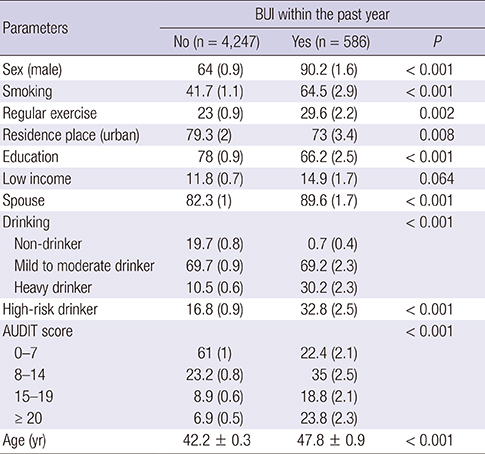1. Orsi C, Ferraro OE, Montomoli C, Otte D, Morandi A. Alcohol consumption, helmet use and head trauma in cycling collisions in Germany. Accid Anal Prev. 2014; 65:97–104.
2. Li G, Baker SP, Sterling S, Smialek JE, Dischinger PC, Soderstrom CA. A comparative analysis of alcohol in fatal and nonfatal bicycling injuries. Alcohol Clin Exp Res. 1996; 20:1553–1559.
3. Li G, Baker SP, Smialek JE, Soderstrom CA. Use of alcohol as a risk factor for bicycling injury. JAMA. 2001; 285:893–896.
4. Park HA. The Korea national health and nutrition examination survey as a primary data source. Korean J Fam Med. 2013; 34:79.
5. Kim Y, Park S, Kim NS, Lee BK. Inappropriate survey design analysis of the Korean National Health and Nutrition Examination Survey may produce biased results. J Prev Med Public Health. 2013; 46:96–104.
6. Park SH, Lee KS, Park HY. Dietary carbohydrate intake is associated with cardiovascular disease risk in Korean: analysis of the third Korea National Health and Nutrition Examination Survey (KNHANES III). Int J Cardiol. 2010; 139:234–240.
7. Andersson AL, Bunketorp O. Cycling and alcohol. Injury. 2002; 33:467–471.
8. Airaksinen N, Lüthje P, Nurmi-Lüthje I. Cyclist injuries treated in emergency department (ED): consequences and costs in south-eastern Finland in an area of 100 000 inhabitants. Ann Adv Automot Med. 2010; 54:267–274.
9. Martínez-Ruiz V, Lardelli-Claret P, Jiménez-Mejías E, Amezcua-Prieto C, Jiménez-Moleón JJ, Luna del Castillo JD. Risk factors for causing road crashes involving cyclists: an application of a quasi-induced exposure method. Accid Anal Prev. 2013; 51:228–237.
10. Park JT, Kim BG, Jhun HJ. Alcohol consumption and the CAGE questionnaire in Korean adults: results from the Second Korea National Health and Nutrition Examination Survey. J Korean Med Sci. 2008; 23:199–206.
11. Reinert DF, Allen JP. The Alcohol Use Disorders Identification Test (AUDIT): a review of recent research. Alcohol Clin Exp Res. 2002; 26:272–279.
12. Zhao G, Wu C, Houston RJ, Creager W. The effects of binge drinking and socio-economic status on sober driving behavior. Traffic Inj Prev. 2010; 11:342–352.







 PDF
PDF ePub
ePub Citation
Citation Print
Print







 XML Download
XML Download